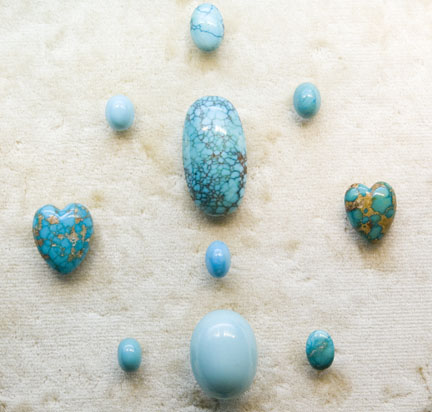
Crystal system: Triclinic
Chemical formula/composition: Hydrated
Copper Aluminum Phosphate: CuAl6(PO4)4(OH)8*5(H2O)
Crystal habit: Occurs
mainly as cryptocrystalline (hidden/microscopic crystals) compact masses
infilling veins
Hardness: 4-5
Specific gravity: 2.6 - 2.8
Luster: vitreous (glassy) to dull
Toughness: fair to good
Cleavage: two, rarely seen because
of cryptocrystalline habit
Optics: semitranslucent to opaque
Color: Light blue to green
Other:
Varieties: Turquoise
can occur as a pure mineral, but is also found in a matrix (typically darker
colored) which can vary
Localities: Worldwide,
but the most important localities are Iran, Turkey, and the southwestern
USA
Common simulants:
Chrysocolla, odontolite (fossil bone that has absorbed iron and turned
blue), colored glass, plastics, or less expensive turquoise that has been
reconstituted either by impregnating with wax or resin. Powdered
material (blue powder, not necessarily turquoise) may be added to a binding
agent such as epoxy to make "reconstructed turquoise."
Synthetics: Synthetics are not
known on the world market, but apparently were made in the 1980s (GIA).
Turquoise is a very attractive sky-blue, opaque stone. It is composed of many microscopic crystals of the mineral that have grown together. Hence, it is really a rock as well as a mineral in most specimens. This should be obvious when you are looking at turquoise in matrix. The matrix is non-turquoise minerals such a limonite (rust) or rock material into which the turquoise depositing fluids infiltrated and precipitated the mineral.
The name turquoise is French and indicates the area of the world where Europeans first purchased the stone, Turkey. However, turquoise has a long history of use, dating back at least to the ancient Egyptians, where it has been found to have been used as far back as 5500 BC.
Obviously, the light blue color, so rare in nature, would attract the eye and turquoise does not need faceting. Carved stone and cabochons are its main uses, and it is also used in mosaics particularly by southwestern Native American artists. Native American turquoise is often set in silver, but turquoise also looks good in gold.
Most turquoise has matrix, but Iranian (Persian) turquoise may be matrix free. Matrix free is most desirable, but the matrix material may impart pleasant appearance as well. Turquoise with matrix may be referred to as: Spider-web turquoise, eggshell, etc.
Turquoise is porous and can be discolored by perspiration, or other penetrating liquids such as cosmetics, skin oils, soap, and dirty water, making the turquoise gain a darker, often greenish, color. Hence, turquoise jewelry should be removed before washing or exercise.
Old turquoise tends to turn green because of absorbing dirt. This is the greatest drawback. Even though turquoise is soft, since it is opaque scratches are rarely very obvious.

Links
Totems to Turquoise at the American Museum of Natural History